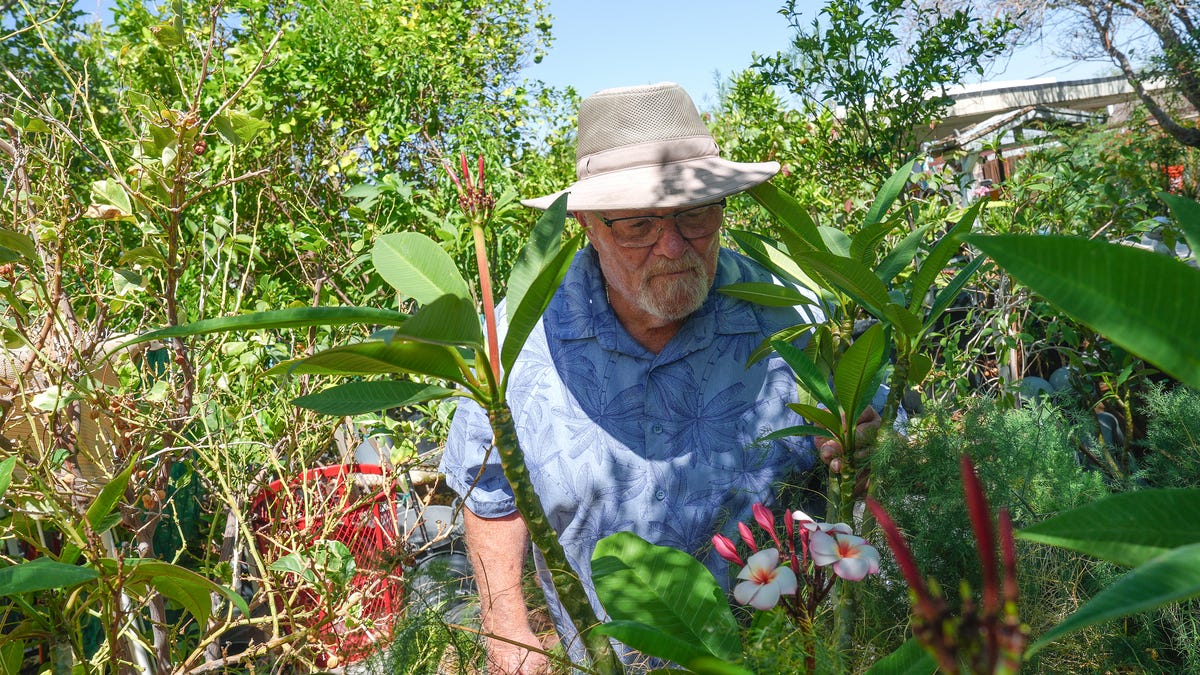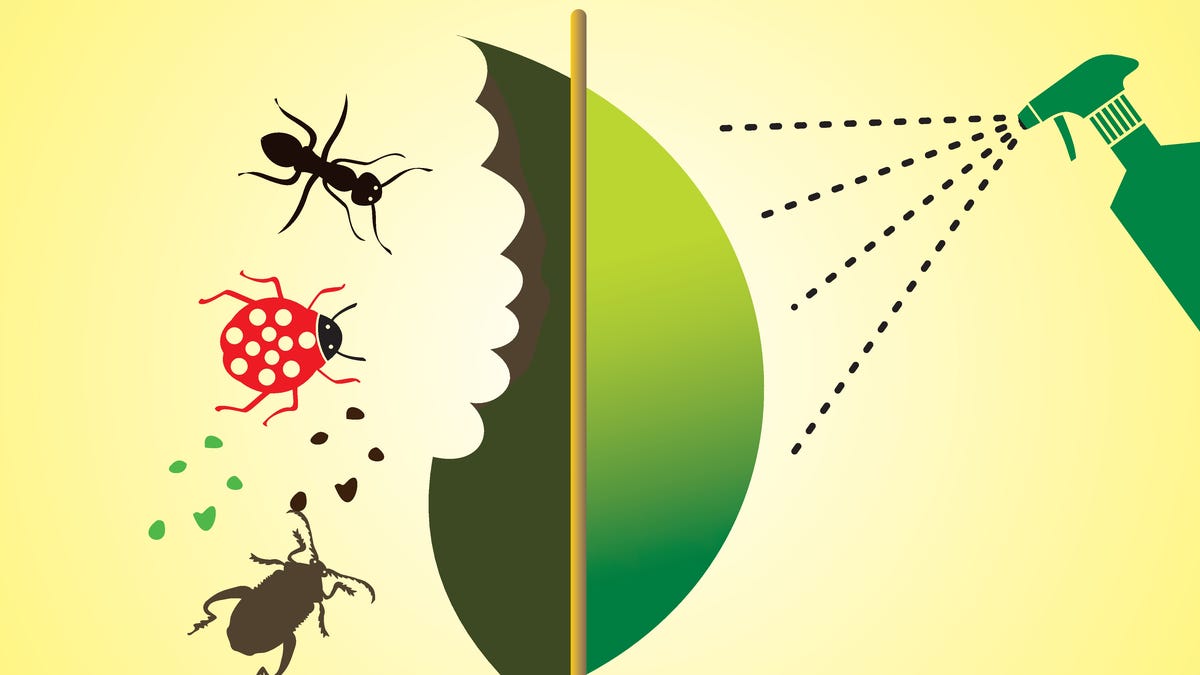How to keep you and your loved ones safe in excessive heat
Check out this video to learn tips for sunscreen application, how to keep children safe and the location of seven Coachella Valley cooling centers.
- Summer heat in the Coachella Valley can be challenging for gardeners, but certain plants can thrive with proper care.
- Experts advise planting established plants or heat-tolerant varieties like melons, squash, and native cacti.
- Key practices for summer gardening include careful watering, soil covering with mulch or shade cloth, and utilizing microclimates.
For gardeners and plant people of all sorts who live in the Coachella Valley, summer is a trying time.
While many edibles and ornamentals can be grown through the area’s mellow winters and can flourish in its temperate spring and fall, summer’s searing heat can have growers bracing for the fruit of their labor to be burned to a crisp.
Loss is a perfectly natural and expected part of gardening, sure. But many plants can survive and even thrive through desert summers if certain steps to care for them are taken.
Area experts have plenty of advice for people who don’t want to stop growing in daily triple-digit heat. Several share their best practices here.
First, let’s establish what should be a commonly accepted fact: Heat can be deadly to more than just plants. People should make informed decisions about when or whether at all to do outdoor work in the summer, limiting their exposure to hazardous weather. It follows, many summer gardeners work in the early dawn or sunset hours until things cool down.
Barbara Levin is a master gardener and the president of the Coachella Valley Garden Club. She said that as gardeners work into summer, it’s much better to have plants that are already established and are doing their acclimating with developed root systems. But that doesn’t mean you can’t plant new stuff if you choose the right varieties.
She tells local gardeners, if they start them early, melons, some squash and peas, cotton and sweet potatoes are among the crops that can survive through summer or at least bear fruit before it gets too hot.
The cactus, palms and succulents anchoring yards around the desert can successfully be planted in the heat, but don’t wait. And getting some advice from a nursery is a good idea should you choose to do so. Keep in mind several opuntia, often commonly called prickly pear, are edible once they establish and fruit.
Some tropical plants, like passion fruit and malabar spinach, are well capable of taking the heat if they’re provided some shelter and are watered well. Buddy Knoles, a master gardener based in Sky Valley, is growing some fascinating tropicals like banana, pineapple he seeded himself and has a prized collection of plumeria.
Some edible crops are surprisingly drought resistant and can keep growing straight through the summer as long as they’re cared for. Arid hardy grains like sorghum, chia and buckwheat have long been farmed in some of the world’s very hot and dry climates. Sunflowers, amaranth and certain types of beans and peppers are native or have been bred to grow in local and neighboring desert regions.
Native Seeds/SEARCH, based in Tucson, Ariz., has a wide variety of these types of food crops that they’ve collected throughout the arid Southwest and Mexico, saving and reproducing them for use. They have a special collection of seeds for hot weather crops.
You might notice how reactive native plants are to rare summer rains, greening with new growth or flowering with changes in the weather. Some of Native Seed’s edible plants were grown by generations of regional farmers in monsoon gardens planted before or after summer storms, taking advantage of seasonal flooding and strategically placed near washes. You can study these methods and design your own version in your yard.
Of course, if you want to skip tracking storms, managing runoff and water storage altogether, you can always grow in trays indoors if the room gets a good amount of natural light through windows or you’re willing to install some grow lights.
But whatever your method of growing, here’s a couple tried and true tips for summer gardening.
Keep plants watered
Water is precious where we live. But the desert also isn’t the wasteland it’s often made out to be in popular culture. Take a look at the many types of crops grown commercially in the Coachella Valley. If you plant it at the right time, let it establish and water it carefully (overwatering is a common cause of young plant death), you can keep things growing and keep enjoying the fruit of your labor through the heat.
Many people run drip irrigation systems that soak the soil around a plant’s roots over long periods of time. Drip systems keep water waste down as the deeply saturated soil is less exposed to evaporation.
How you can efficiently irrigate is directly related to how quickly water evaporates where you live. There are maps to help calculate the normal rates of water evaporation and how much irrigation should be expected to keep plants alive in different parts of the valley.
Knoles has planted apples, avocados, stone fruits and more in pots he has hooked up to drip irrigation that soaks each plant’s roots through a funnel buried into the plant’s pot. Timing is important, he reminded. While he does some hand watering, he has his system on a timer to provide a steady rhythm to the watering.
“For desert growing, it’s all about creating microclimates like this,” Knoles said as he walked through the circuitous rows of potted fruit and flowers in his yard.
But growers can also cultivate more of the native plants that are already well suited for their specific climates. Roger Tansey, another master gardener, designed and planted a pollinator garden open to the public outside of the Palm Springs Animal Shelter.
“It’s there to save the monarch butterfly, but everything planted is selected for its drought tolerance and ability to survive here in the desert,” Tansey said.
He focused on planting desert milkweed for the butterflies’ benefit, a native plant requiring relatively little irrigation. Tansey stressed the importance of planting pollinator gardens because a lot of these essential native plants are losing habitat to development and changing climate. These blooms can support a variety of native butterflies, bees and even bats.
“The more flowers you plant, the better,” Tansey added.
Keep soil covered
Critical to careful watering is good cover to prevent wasteful evaporation. Knoles places his pots of fruit trees under larger landscaping trees in a part of his yard sheltered from the howling winds that can plague the area. Although the small fruit trees are mostly sheltered by the larger mesquite and ficus, they still get plenty of light to grow.
While he makes good permaculture use of the large landscape trees on his property to shield the younger ones, you can make it work in a yard without them.
I’ve heard of soil working for plants the way our stomachs work for our bodies. Just like the biome that helps us digest food, essential nutrients for plant life are made available to plant’s roots by the microbes buried beneath our feet. Protecting that biome from getting baked by the sun is crucial if you want to keep it alive. That way all the microorganisms doing all that important recycling and feeding work can do their jobs with the help of proper hydration.
Some people make extensive use of shade cloth which can keep the sun at bay. This can be really effective, but almost always requires some sort of framing or construction project to keep secure for when the wind inevitably starts whipping.
Others use landscape fabrics that can be placed directly on the ground around the plant. This can be staked or stacked on top of to keep the fabric down. It’s important to be mindful that these materials can absorb heat if they’re dark in color and fully exposed to the sun, which may do more harm than good.
Mulch is used by many because it not only acts as a shading barrier, it also eventually breaks down and feeds the plants too.
“When temperatures get extreme, having a good layer of mulch prevents soil from heating up excessively and loosing water to evaporation,” said Levin. A 4 inch layer of a medium shred bark mulch to insulate the soil is best, she said.
You can purchase mulch from a garden section or supply. But you can also make use of all kinds of recycled stuff. You can use wood chips from landscaping projects or the partially composted remains of other plants that didn’t make it. Just about every day a tree is being trimmed somewhere in the sprawling Coachella Valley, it seems. Ask landscapers where they take their scraps or if they’ll give you some.
Keep things moving
If things are still green and growing, keep tending. Experiment with different plant placements. Keep starting new seeds. When things die, throw them in the compost pile and try something different.
Many in the desert grow in pots and all sorts of objects that can be moved around houses, trees and other structures that can provide shade and protection when needed. And even moved indoors when it gets too hot or too cold.
Tansey for years successfully grew what he thought was a “dwarf orange tree” in a pot until it got so big he had no choice but to put it in the ground. Citrus do love the Coachella Valley.
He’s doing similar experiments currently with different kinds of herbs: mint, oregano, lavender, thyme and garlic chives. A variety of basil can be heat hardy. He likes to keep his first experiment with growing a new plant in a pot so he can move it as he observes its preference for sun and other factors. The small plants can grow decently well on the shady side of a house with only morning sunlight exposure, he said.
Knoles said he’s spent considerable time ordering the maze of potted fruit trees in his yard. He’s even carefully placed them on top of paver stones so the larger trees that shade them don’t put roots vertically into the pots and choke them out.
There’s always next year
And if things don’t go your way and you’re left with a small field of parched stubs or pots of burned branches, you can always let things have a rest. Summer can be a great time to fallow and plan for the next season. If you’re not growing plants, do yourself a favor and grow some soil. Bury some kitchen scraps. Throw down some compost or manure. Cover it all with a thick layer of woodchips or cardboard and let it break down. Water it occasionally to keep it alive. It’ll be like starting to cook the meal for your future plants to feast on in the fall.
Knoles and Tansey can often be found volunteering at the Palm Springs Farmers’ Market on Saturdays from 8 a.m. to 1 p.m. inside the Palm Springs Pavilion at 401 S Pavilion Way.
Levin hosts public presentations on gardening every second Wednesday of the month at the Palm Desert Library at 10:30 a.m. and the last Wednesday of the month at the Cathedral City Library, 6 p.m.
Pay them a visit with your questions or drop in for a chat.









